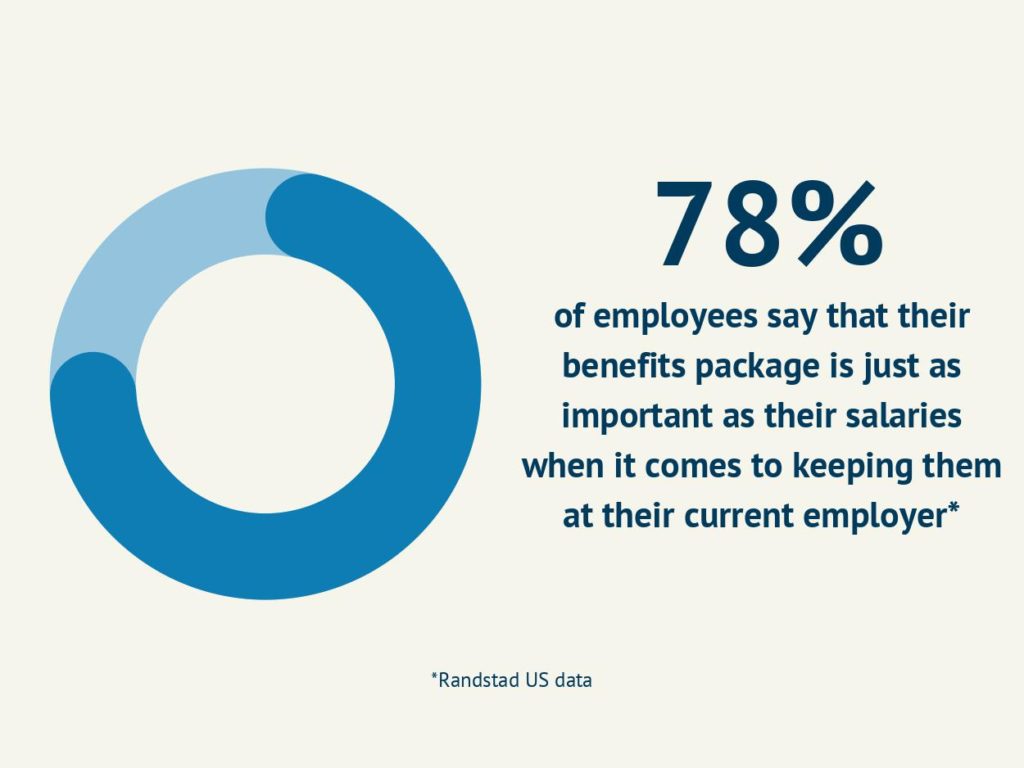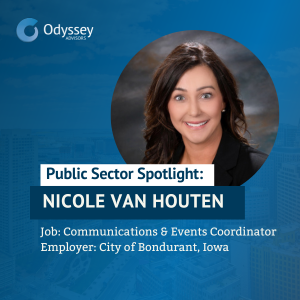Why You Need a Competitive Employee Benefits Package
August 3, 2021|Stephanie Irvin

Bottom Line Up Front
- Employee benefits are the additional perks, either tangible or intangible, that an organization offers on top of an employee’s salary as part of their total compensation package.
- Organizations are using these benefits to retain current employees, attract new talent, mitigate taxes, and increase morale.
- The most sought-after benefits in 2021 include increased healthcare, remote/flexible work options, childcare, and family benefits, and additional lifestyle benefits.
What are Employee Benefits?
Let’s start this from the top and define exactly what an employee benefits package is. Employee benefits packages are the additional perks, either tangible or intangible, that an organization offers on top of an employee’s salary.
Think back to when you were between the ages of 21 and 25 years old. That’s right around when you most likely got kicked off of your parent’s health insurance plan. For most of us, that was the first time you had to take a step back and look at your employer’s benefits package without the rose-colored glasses on.
The benefits offered vary from business to business. Some are required by law while others are voluntary. Employee benefits can also be used as a way for organizations to retain current employees, stand out from their competitors when trying to attract new talent, mitigate taxes, and increase morale.
The Basics
Most Commonly Offered Benefits
While some of these benefits are legally required, others are not. Here is a general list of the most common benefits offered in an employee benefits package:
- Health Insurance
- Retirement Savings Plan
- Additional insurance such as life and disability
- PTO for vacation, sick days, and personal days
- Remote/hybrid and flexible schedule options
Your workforce is what drives your business so that’s why many business owners want to offer benefits that will help recruit and retain top talent.
Legally Required Employee Benefits
As an employer in the United States, you’re required to participate in and contribute toward certain employee benefits. The Department of Labor describes these benefits as those that provide workers and their families with a retirement income and medical care, mitigate economic hardship resulting from loss of work and disability, and cover liabilities resulting from workplace injuries and illnesses.
These benefits include:
- Time off to vote, serve on a jury, and perform military service
- Provide worker’s compensation
- Social Security, Medicare, and FICA
- Unemployment insurance
- Family and Medical Leave (FMLA)
- Private employers with 50 or more employees and all public sector businesses are required to provide a maximum of 12 weeks of unpaid leave in a 12-month period to be used as per the DOL.
- Health insurance
- This is only required by businesses with 50 or more full-time employees
Voluntary Employee Benefits
Voluntary benefits, also known as supplemental benefits, are those offered by employers, typically used to entice and retain employees, mitigate taxes, and increase overall morale. These benefits can range from additional health coverage including vision and dental to lifestyle benefits or employee perks. They are typically cheaper through an employer since they can get reduced group pricing.
As mentioned above, you aren’t obligated to offer these supplemental benefits, but to stay competitive in the job market and retain your current employees, these benefits have become vital. Another benefit (pun intended) is that these benefits are another way to decrease your payroll taxes and increase job satisfaction.
Below is a list of common voluntary benefits offered today:
- Retirement savings plans (i.e. 401(k), Profit Sharing, 403(b), Cash Balance Plan)
- Hospital indemnity insurance
- Dental & Vision insurance
- Disability insurance
- Gym memberships
- Financial Management services
- Life insurance
- Remote and flexible work schedule
- Pet insurance
The list doesn’t end there. Organizations are starting to get more creative to stay competitive in the job market and employees are placing greater emphasis on supplemental benefits as they consider changing jobs. One study revealed that 78% of employees say that their benefits packages are just as important as their salaries when it comes to keeping them at their current employer.
Most Valuable Benefits Employees are Looking For in 2022
There are a lot of benefit plans out there so how do you know what your employees will be looking for? Since the pandemic, there has been a momentous shift in how both employees and employers look at benefits.

Many believed that employers would decrease their benefits, but that wasn’t the case. According to a recent study conducted by Unum, employers are wanting to add additional benefit packages to protect their employees after seeing what the pandemic has done. They’ve seen disability, critical illness, and viral/infectious disease coverage as the most frequently listed benefits that businesses were adding because of the pandemic.
According to the Employee Benefit Research Institute’s (EBRI) 2020 Workplace Wellness Survey, seven out of ten employees agreed that they need their employer’s help ensuring they are healthy and financially secure. They also felt that employer-offered benefits contribute to their feelings of financial security.
#1 Health Insurance
The Society for Human Resource Management (SHRM) found that healthcare is consistently ranked as the most important benefit category. They found that Preferred Provider Organization (PPO) plans are the most popular health insurance options, followed by high-deductible health plans (HDHPs).
According to their study in 2019, 85% of employers offer PPO, and 59% percent of employers offer HDHP linked to a health savings account (HSA)/health reimbursement account (HRA).
There are also more voluntary health insurance options that you can offer to supplement your standard health insurance plans such as:
- Accidental death & dismemberment (AD&D)
- Dental & vision
- Hospital indemnity
- Long-term disability
- Short-term disability
- Accident coverage
- Critical illness
- Mental health coverage
When you provide your employees with well-rounded health benefits, it’s been shown that they’ll take fewer sick days, feel more satisfied with their job, and gain a sense of security which leads to more productivity and better profit margins.
#2 Remote and Flexible Work Schedules
Before the pandemic, remote and flexible work schedules were heard throughout the grapevine, but no one put much thought into it. It was similar to the gossip of a 4-day workweek. You’d hear about it from a friend of a friend or come across a news article about some progressive company testing the waters, but it was this far-fetched idea.
Now, most employees have gotten a taste of it as states issued stay-at-home orders during the pandemic. As the country is opening back up, more employees are requesting that remote and flexible work schedules become the norm.
According to a study conducted by Mercer, 87% of employers say they will embrace greater flexibility post-pandemic – with most planning to maintain the hybrid model of onsite/work-from-home options. It’s important to note that not all of these options are feasible for every organization. If you’re considering remote or flexible work options, make sure to assess your organizational needs along with your employees’ needs to determine if there’s a reasonable option that works for both parties.
#3 Childcare and family benefits
Many working parents juggled jobs and childcare during the pandemic. When schools closed and classes became virtual, many had to pivot when and where they worked or take a leave of absence to stay home with their children. Data gathered by Pew Research showed that almost double the number of women vice men quit the labor force in the first year of the pandemic. 2.4 million women and 1.8 million men left the workforce between February 2020 and February 2021.
Many organizations noticed this trend and have responded by increasing childcare and family benefits to mitigate the loss of skilled employees. Some of these benefits include:
- Backup care
- On-Site child care
- Eldercare
- Flexible Schedules
- Flexible childcare spending accounts
- Childcare subsidies
- Additional paid parental leave
#4 Lifestyle Benefits
Lifestyle benefits, also known as employee perks, are non-salary-related benefits that are given to employees to improve their lifestyles. Unless you’ve been living under a rock, you’ve heard about Google’s infamous employee perks. Things like free gourmet food and snacks, being able to bring your pets to the office, massage credits, extended maternal and paternal leave, increased death benefits for spouses, free fitness classes, gym memberships – and the list goes on.
These benefits provide employers an edge in how they differentiate themselves from competitors in the job market. They’ve also been proven to increase employee engagement, retention, and satisfaction. They provide a way to personalize your organization’s employee experience.
How to Showcase Your Employee Benefits Package
Share your policies, perks, and procedures when you’re interviewing a new candidate. When you make a job offer, add the benefits to the offer letter as part of their total compensation package. This is a great way to showcase the complete value of what you’re offering. Yes, you can include numbers! You can even do this with your current employees on an annual basis. Include everything that is part of your compensation package – health insurance, dental, salary, paid leave, retirement benefits, flexible spending accounts, etc.
Snap a picture of everyone sitting down for lunch together that you provided and share it on your LinkedIn, incorporate direct quotes or short videos from your employees about the support these benefits bring them whether that’s through their personal goals, their health, being able to care for loved ones without worrying about their job, etc. Everyone loves a good story and this is the perfect way to showcase your company culture and the benefits of working there.
Conclusion
Recruiting and retaining top talent requires a competitive, top-tier benefits package, more so now than ever before. Make sure your employee benefits are meeting your employees’ basic needs and then ask them what they would like to see more of. An anonymous survey is a great way to give your employees a safe space to open up. Do your research on the market, look at what your competitors are offering, and take into account what your employees would like.
Benefits shouldn’t be viewed as another expenditure – rather, think of them as an insurance policy for your business and your employees. With the pandemic (mostly) behind us and the increasing pressure from the great resignation, now is the time to start reevaluating the benefits you already offer.
If you have any questions or need further information, please reach out to one of our Odyssey consultants. We’d be happy to help.
Categories: Business, Retirement

About The Author Stephanie joined the Odyssey Advisor’s team all the way from the Lonestar state in November of 2020. She is versatile in her abilities and has experience in copywriting, photography, and analytics. She helps tell our brand story and convey...
More Insights From This author

October 15, 2024
Stephanie Irvin

November 29, 2023
Stephanie Irvin

November 15, 2023
Stephanie Irvin





